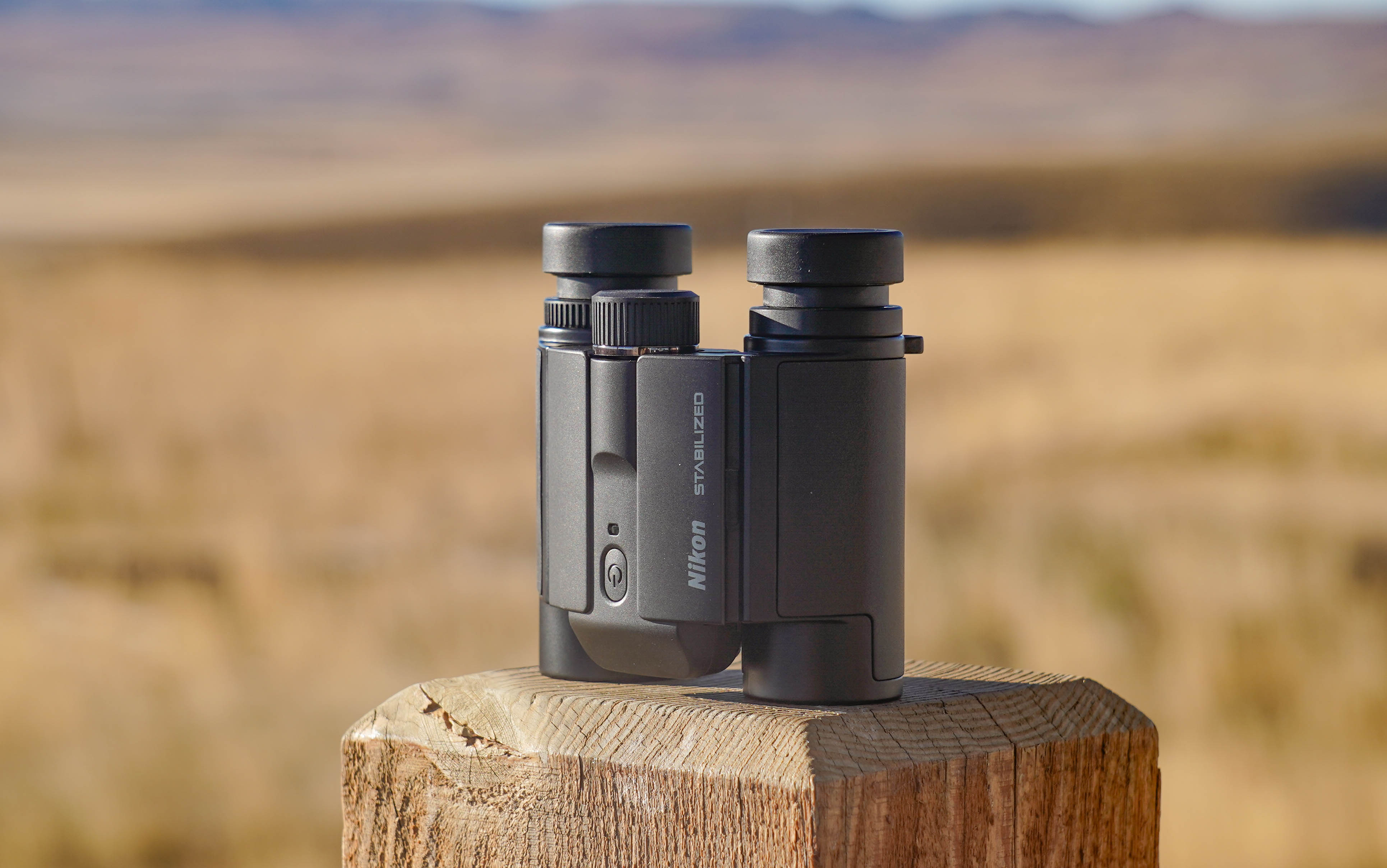We may earn revenue from the products available on this page and participate in affiliate programs. Learn More ›
I love gear that solves a real problem. But I doubly love gear that solves two or more problems with elegant solutions.
The brand-new Nikon Stabilized Binocular is a pipsqueak of an optic, and the 12x25mm version easily fits in the palm of my hand. However, the addition of image stabilization turns this tiny binocular into an impressive mid- to long-range optical instrument.
Photo by Andrew McKean
See It
- Length: 3.9 inches
- Width: 3.5 inches
- Depth: 2.6 inches
- Uses AA batteries
- Available in 10x and 12x
- Stabilizes movement by 80 percent
- Field of view at 1,000 yards: 236 feet
- Weight: 17.14 ounces (with batteries)
A Look at the New Image Stabilized Binoculars
The problems the Nikon Stabilized 12×24 solves originate in that diminutive configuration. Most super-compact binoculars are in the 7- to 8-power range, with a few 10×24 binoculars on the market. Going up in magnification with that tiny objective lens results in a tiny exit pupil, which is the little bright circle that you see if you hold a binocular (or rifle scope, or spotting scope) at arm’s length and look at the eyepiece.
Without going all optics-nerd on you, exit pupil is calculated by dividing the objective lens by the magnification. So, a 10×42 binocular has a 4.2mm exit pupil (42mm objective lens divided by 10-power). A 12×56 binocular has a 4.67mm exit pupil, which is why images delivered by that larger binocular can appear brighter than those of a 10×42 or a 12×50.
But consider the poor super-compact binos. Those 8×24 binoculars have a puny 3mm exit pupil, and it’s even smaller (2.4mm) with the 10×24 binoculars. Nikon’s new 12×25 binocular has a stingy 2.1mm exit pupil, which means it’s really only going to deliver an adequate image in broad daylight, when the user’s pupil is small anyway. Recall that the human pupil, like a camera lens opens up in dim light conditions to let as much light as possible in to the retina.
Read Next: Best Compact Binoculars
Back to that first problem: Most brands use lower magnifications in their super-compact binoculars in order to deliver larger exit pupils, but that low power limits their use to close- to medium-distance glassing. The 12-power Nikon solves that problem by offering a lot more reach.
But compact binoculars are notoriously hard to hold steady. Those mid-sized 10×42 and 12×50 binoculars have a certain heft that settles in the hand. The little 24 and even 30mm binos are antsy, darting around because they’re so light and because there’s so little frame to hold. Here’s where the image stabilization saves the day.
Turn on the stabilization module, and the Nikon’s 12-power image becomes crisp and clear. Turn it off, and the image is still okay, but it suffers from hand shake and over-magnification. If you turn the module back on with the switch located on the binocular’s bridge, and the image settles and sharpens. Nikon engineers report an 80 percent reduction in vibrations caused by hand shake (these engineers call these sinusoidal waves) with the image stabilizer engaged. I didn’t measure the shake reduction, but it’s significant and noticeable, and the reduction becomes even more apparent in lower-light conditions when any shake is magnified.
The remarkable detail about the new Nikon — it just entered the market earlier this month — is its size, about 4×4.5 inches, weighing less than 14 ounces, and easily fitting in a jacket pocket. Most image-stabilized binoculars are super-sized. We evaluated Sig Sauer’s new ZULU6 HDX 16×42 in this year’s Outdoor Life optics test, and while it does a marvelous job of settling the image, it’s the size of a deli sandwich.
The new Stabilized Nikon is available in a 10x25mm as well as the 12x25mm version that I tested. The 10-power will retail for $639, while the 12-power sells for $649.
The stabilization is powered by twin AA batteries that tuck under the center hinge. The company claims 12-hour run time on the batteries, and while I didn’t test that duration, I would imagine that casual users will get twice that. Controls, from the center focus knob to the eyecup extensions, are undersized but serviceable. The glass and coatings are good but not especially eye-popping.
The new binocular is covered by Nikon’s limited lifetime warranty that extends only to the original buyer. Some of the electronic components have more limited warranty terms.
Final Thoughts
It’s a little strange that Nikon is just now introducing an image-stabilized binocular. The company has led the camera industry in what it calls VR (for vibration reduction) lenses. Maybe you have one. You hear a little sizzle from deep inside the lens when you engage the VR feature. That’s the electronic gyroscope activating to cancel out all manner of up, down, and crossways vibrations, allowing users to get crisply focused images even in low light or when subjects are moving. Later, Nikon incorporated the VR module in its premium EDG spotting scope in 2011. The company then came out with the first image-stabilized laser rangefinders. Readers may remember the COOLSHOT laser rangefinder with a very effective stabilization module.
My optics-test archives indicate there was a 14×40 Nikon VR binocular way back in late ‘90s or early 2000s, but it didn’t have the compact build, small and unobtrusive stabilization module, or quality glass and coatings of the new binocular. And it didn’t last long.
You won’t use Nikon’s new 10×25 or 12×25 for serious glassing. You’ll have a big binocular or spotting scope for that. But for a very capable go-anywhere travel binocular, treestand optic, or as a pickup binocular that can make quick and certain identifications from mid-distance to way out there, Nikon’s new Stabilized Binocular is a very useful and welcome addition to the new wave of electro-optics.
Read the full article here
